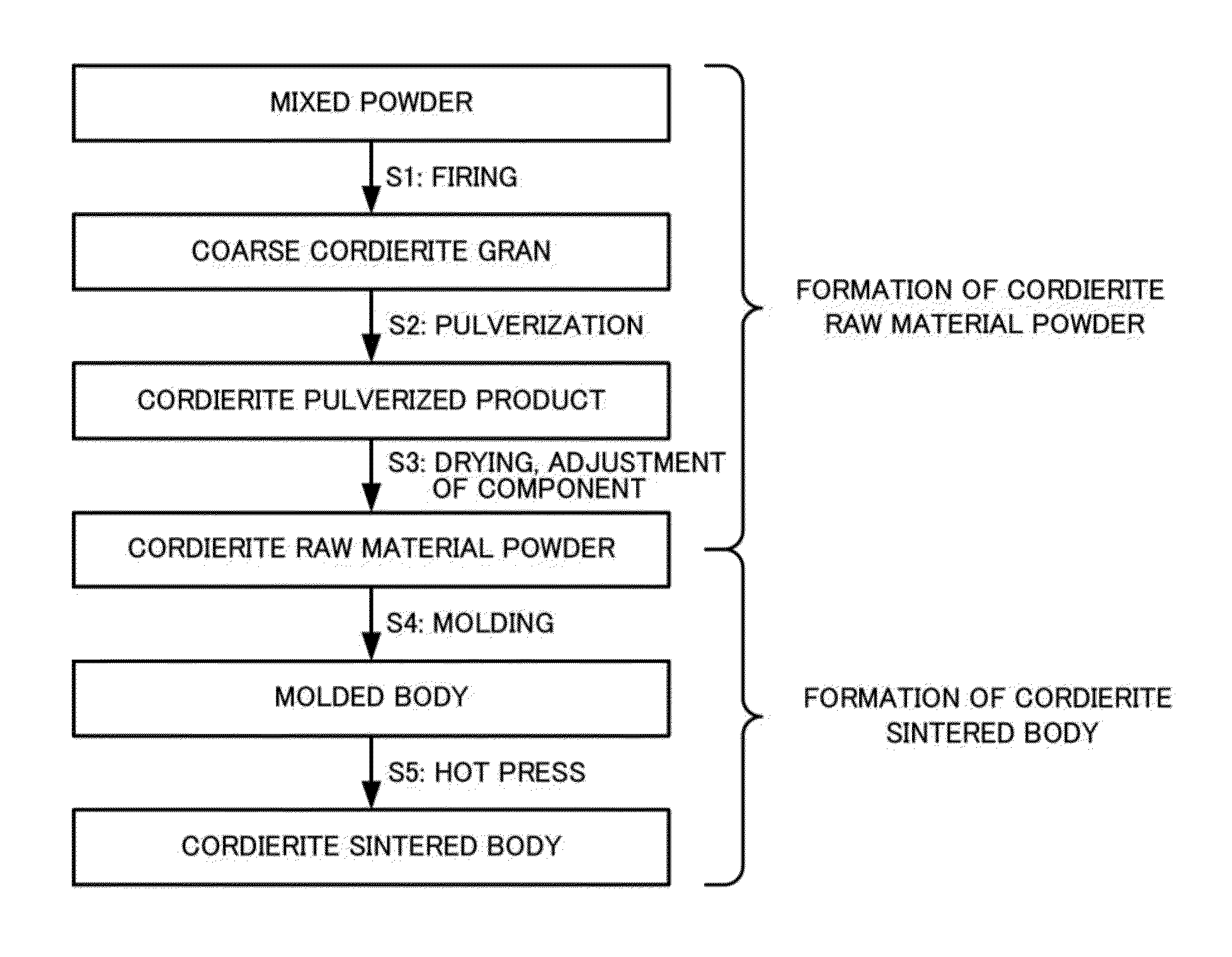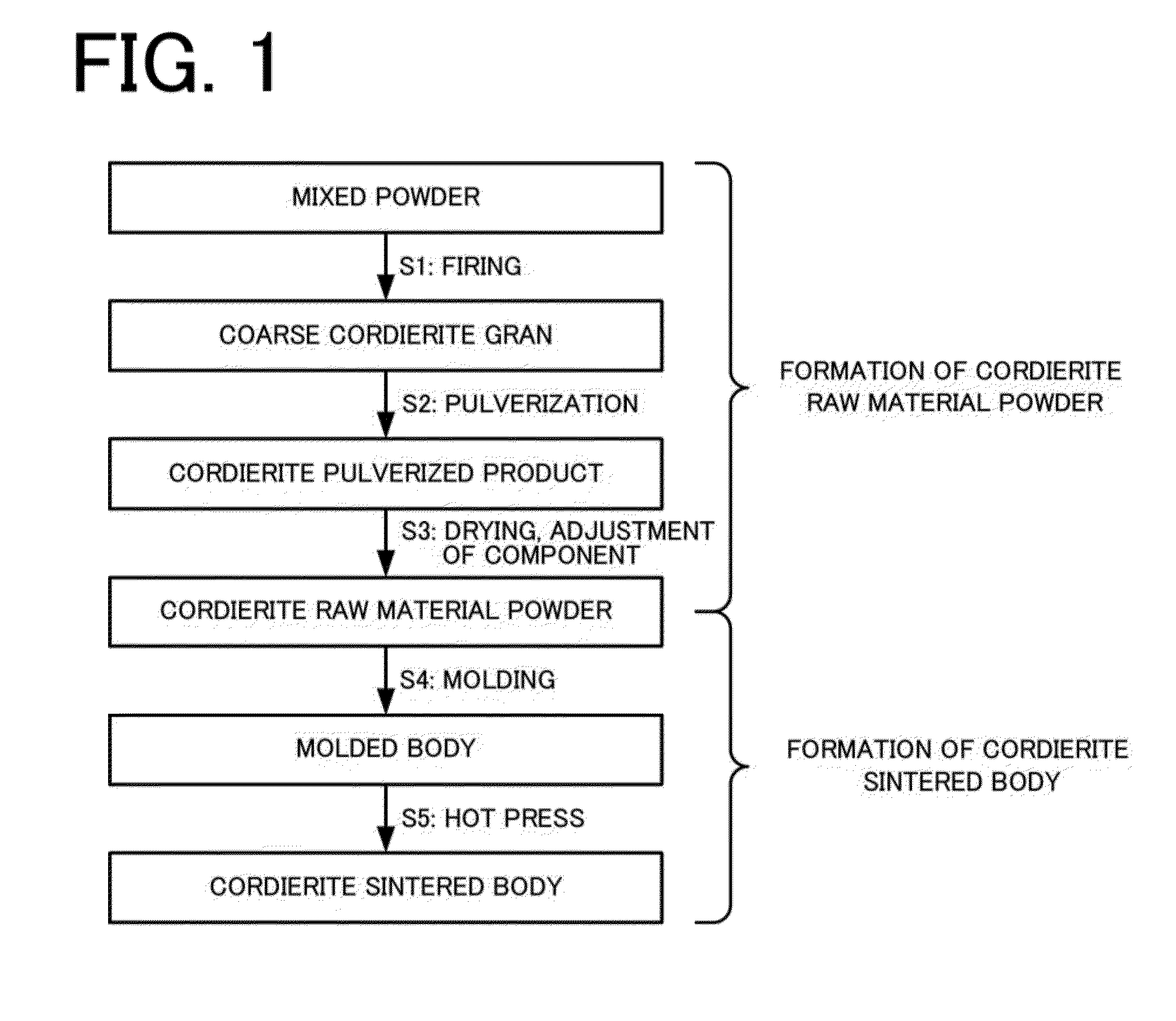Cordierite sintered body, method for manufacturing the same, composite substrate, and electronic device
- Summary
- Abstract
- Description
- Claims
- Application Information
AI Technical Summary
Benefits of technology
Problems solved by technology
Method used
Image
Examples
experimental example 1
[0077]A cordierite sintered body of Experimental Example 1 was obtained by sintering the cordierite raw material powder A at a press pressure of 200 kgf / cm2 and 1,425° C. for 5 hours. The molar ratios of MgO / Al2O3 and SiO2 / Al2O3 of the cordierite sintered body thus obtained were 1.00 and 2.50, respectively, and were not so much shifted from the stoichiometric ratio of cordierite, and the amount of impurities was also small. The bulk density of the sintered body was 2.507 g / cm3 and was remarkably closed to a cordierite true density of 2.505 g / cm3, and it was found that closed pores were hardly contained. FIG. 4 shows an XRD diffraction diagram of a pulverized product of the cordierite sintered body of Experimental Example 1. Although corundum (• in the graph) was only detected as a phase other than that of cordierite, the peak intensity ratio Ix to the peak top intensity of the (110) plane (∘ in the graph) of the cordierite was extremely small, such as 0.0020. FIG. 5 shows the result...
experimental examples 2 and 3
[0078]Cordierite sintered bodies of Experimental Examples 2 and 3 were obtained by sintering the cordierite raw material powders B and C, respectively, under the conditions similar to those of Experimental Example 1. The compositions of the cordierite sintered bodies thus obtained and the molar ratios of the components thereof were as shown in Table 2, and the shift thereof from the stoichiometric ratio of cordierite was significantly small. As for the other characteristics, characteristics similar to those of Experimental Example 1 were obtained, and sintering could be densely performed with a small number of pores while the amount of the different phases was small; hence, it was found that a material having a high surface flatness could be obtained. The transparency was also high as was the case of Experimental Example 1.
experimental example 4
[0079]In Experimental Example 4, except that the firing temperature was set to 1,400° C., a cordierite sintered body was formed under conditions similar to those of Experimental Example 1. It was found that since the firing temperature was low, a cordierite-forming reaction of raw material components, such as alumina and silica, was not sufficiently advanced, and a large amount of different phases of corundum and cristobalite remained. As for the surface flatness of the polished surface, the center line average roughness Ra was high, such as 1.8 nm, and the maximum peak height Rp was large, such as 28 nm. From the results described above, it was estimated that the degree of polishability was different between cordierite and the different phase component and in particular, that since not easily polished, the different phase component was liable to remain in a convex form.
PUM
| Property | Measurement | Unit |
|---|---|---|
| Percent by mass | aaaaa | aaaaa |
| Pressure | aaaaa | aaaaa |
| Diameter | aaaaa | aaaaa |
Abstract
Description
Claims
Application Information
 Login to View More
Login to View More - R&D
- Intellectual Property
- Life Sciences
- Materials
- Tech Scout
- Unparalleled Data Quality
- Higher Quality Content
- 60% Fewer Hallucinations
Browse by: Latest US Patents, China's latest patents, Technical Efficacy Thesaurus, Application Domain, Technology Topic, Popular Technical Reports.
© 2025 PatSnap. All rights reserved.Legal|Privacy policy|Modern Slavery Act Transparency Statement|Sitemap|About US| Contact US: help@patsnap.com



